| Xinjiang Today |
| Eternal glow, lasting soul | |
|
|
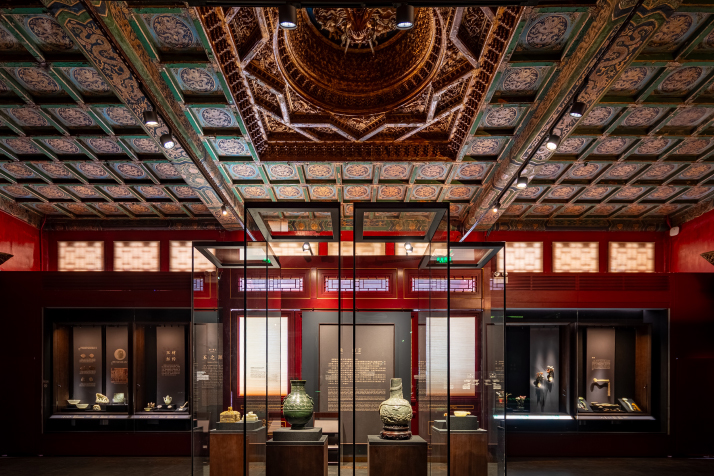 The Palace Museum's Jade From the Kunlun Mountains: Special Exhibition on Hetian Jade Culture in the Qing Court opens in the Zhaigong (Palace of Abstinence) Gallery on January 7. It will run for one year (COURTESY OF THE PALACE MUSEUM)
As the soft gleam of jade catches the morning light filtering through the grand halls of the Palace Museum, the former imperial residence in Beijing, a story thousands of years in the making quietly unfolds.
At the Zhaigong (Palace of Abstinence) Gallery, the artifacts from a special exhibition of this year, Jade From the Kunlun Mountains: Special Exhibition on Hetian Jade Culture in the Qing Court, stand in quiet anticipation of the visitors of a new day, who will be awed by their beauty. The Palace Museum was established in 1925 at the Forbidden City, the official imperial household of Ming and Qing dynasties from 1420 until 1924. In Chinese culture, jade has long symbolized virtue, purity and harmony. The ancient Chinese philosopher Confucius once likened the gentleman to jade and praised its luster as a metaphor for kindness, its translucence for loyalty and its resonance for wisdom. Among all varieties, Hetian jade, named after the city of Hetian (Hotan) in Xinjiang, holds particular value in Chinese tradition, cherished for its creamy texture, soft gloss and profound cultural meaning. Having opened on January 7, the exhibition will run for one year. It features 258 artifacts, ranging from imperial seals and ceremonial instruments to intricately carved ornaments and everyday objects. No fewer than 130 of these pieces are on public display for the first time. "Focusing on Hetian jade from Xinjiang, this exhibition presents representative masterpieces from the imperial collection of the Qing Dynasty (1644-1911), aiming to interpret the dynasty's jade culture and highlight the interactions, exchanges and integration among the various ethnic groups during that time," said Huang Ying, the exhibition's curator, in an interview with Xinjiang Today. 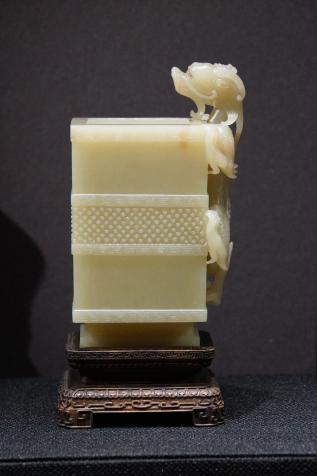 A yellow jade gong (libation vessel) from the Qianlong reign of the Qing Dynasty (1644-1911) is engraved with a dragon motif and the emperor's reign mark (WANG YAJUAN)
From the Kunlun Mountains Hetian jade's origins lie deep in the Kunlun Mountains, a majestic range that has been central to Chinese mythology and history, in south Xinjiang. Within its snow-covered peaks, ancient riverbeds and glacial streams, one will find the jade deposits that have formed through tectonic movement, mineral infusion and the passage of time. Hetian jade has long been admired for its texture and touch. The variety is rich in tremolite, a mineral that gives the stone its distinctive warm, waxy feel, coming in hues ranging from milky white to green and golden yellow. Huang said archaeological evidence indicates jade has been used in Xinjiang for over 4,000 years. "From the mid-Western Han Dynasty (206 B.C.-A.D. 25) onward, large quantities of Hetian jade began to be transported to the Central Plains, considered the heartland of ancient China, gradually becoming the primary material for jade carving over the next two millennia." Known as the recorded earliest Hetian jade artifact in the Palace Museum's collection, a white jade figurine of bixie (a mythological creature) at the exhibition demonstrates Hetian jade's early appeal in the Central Plains during the Western Han. With its lion's face, curled horns and crouching posture, the bixie embodies both strength and mythical symbolism, believed to ward off evil. Thanks to the opening of the Silk Road, transportation became more convenient. By the Song Dynasty (960-1279), Hetian jade from Xinjiang had gradually become a primary material for jade carving, and trade in the stone flourished. During the Ming (1368-1644) and especially the Qing dynasties, jade craftsmanship had reached new heights in the imperial court. This led to greater demand for top-quality raw jade. 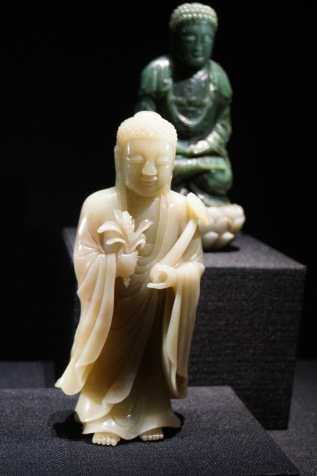 Qing Dynasty Buddhist statues carved in Hetian jade (WANG YAJUAN)
Treasures of the Qing court In 1761, Hetian jade was officially designated as a tribute to the Qing court, delivered twice a year in spring and autumn. The subsequent establishment of a well-organized system of mining, transportation and craftsmanship reflected the Qing government's effective governance of its western frontier. Court archives show that more than 2,000 kg of jade were sent as tribute annually from Hetian and Kashi (Kashgar), with the total reaching 10,000 to 15,000 kg in peak years. This practice reached its height during the reign of Emperor Qianlong (1735-96), a jade art enthusiast. "The Qing court selected only the finest jade for crafting artifacts, while the rest was stored in palace warehouses," Huang explained. "This ensured a consistent supply. Combined with the emperor's personal interest, it greatly encouraged the development of jade craftsmanship both in the court itself and in non-official workshops." Qianlong set exceptionally high standards. Upon receiving raw jade, he personally decided whether to store it or craft it, what to make and which artisans would do the job. For special pieces, designs had to be submitted for his approval, often created by master artists. Only then could carving begin. One highlight of the Hetian jade exhibition is a jade sculpture resembling a miniature rockery that captures a vivid scene of jade mining in the mountains. It features eight miners working along a steep path: One leads with a staff, while others carry jade blocks on their backs, shoulders or in carts. At the entrance to the carved mountain scene, a figure approaches a grand gate. On the reverse side, a poem by Qianlong is engraved, honoring the hard labor of those involved in jade extraction. Using Hetian jade as their primary material, Qing artisans built upon earlier traditions to create refined and technically advanced works, Huang continued, adding that most of these pieces, particularly from the Qianlong period, are now preserved inside the Palace Museum. 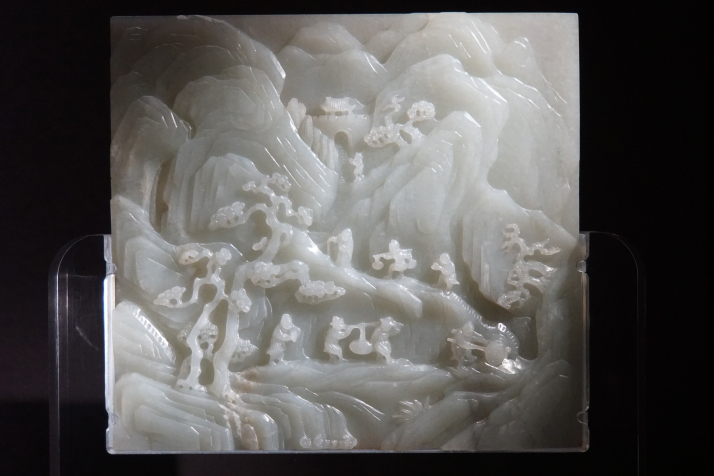 A greyish-white jade screen featuring a jade gathering scene, with a poem by Emperor Qianlong (1736-95) carved on the reverse (WANG YAJUAN)
Inspiration strikes To better curate the exhibition, Huang and another 13 colleagues from different departments of the museum traveled to Hetian and Kashi cities from October 10 to 17, 2024. There, they conducted fieldwork, engaging with local museums. The team visited an ancient quarry along the Yulong Kashi River, a river that flows from the Kunlun Mountains through Hetian. The site is believed to be one of the earliest sources of Hetian jade. The team observed on-site jade extraction and modern mining procedures. They also toured an industrial base to study contemporary jade processing techniques. "The trip provided a more comprehensive view of Hetian jade's origins, development and culture," Huang said. One thing that left a strong impression on Huang was the vastness of Xinjiang. Even with modern transportation, conducting field research is challenging in many ways, highlighting just how difficult the mining and transport of jade must have been during the Qing era, she explained. "This experience provided a deeper understanding of the hardships described in historical documents and imperial poems, which often depict the arduous process of extracting jade from mountains and riverbeds." 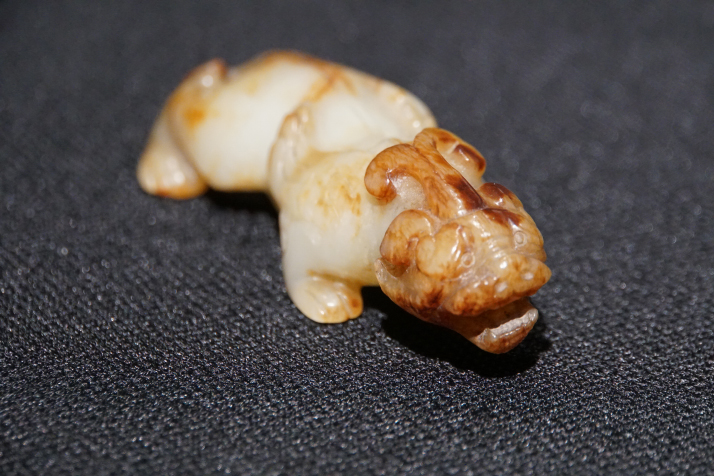 A white jade figurine of bixie, the recorded earliest Hetian jade artifact in the Palace Museum collection, dating back to the Western Han Dynasty (206 B.C.-A.D. 25) (WANG YAJUAN)
Video materials collected during the trip are on display in the multimedia section of the exhibition, allowing visitors to explore more dimensions of Hetian jade culture alongside historical objects. To expand on the exhibition's themes, the Palace Museum has launched a lecture series exploring jade culture and the history of Xinjiang. One standout example was the second episode, held on May 9, which featured Xu Jianying, a research fellow at the Chinese Academy of Social Sciences. Xu examined the Qing government's strategies for governing Xinjiang and their overall effectiveness. According to Huang, the exhibition was jointly planned with the Cultural Heritage Bureau of Xinjiang. This collaboration will continue in July, with another exhibition co-hosted at the Xinjiang Uygur Autonomous Region Museum. That exhibition will showcase cultural relics from Xinjiang during the reigns of Qing emperors Kangxi, Yongzheng and Qianlong (1662-1796). Cultural relics can tell the stories of Xinjiang and present China to the world, contributing to the promotion of fine traditional Chinese culture and the consolidation of the sense of community for the Chinese nation, Huang said. Comments to liqing@cicgamericas.com |
|
||||||||||||||||||||||||||||
|